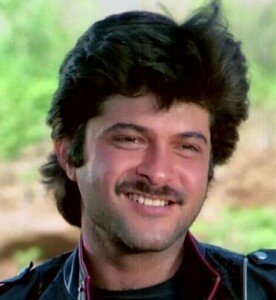Anil Kapoor and the Changing Face of India
Written by Arghya // April 27, 2012 // Media & Popular Culture // 3 Comments
India is changing. The rich are getting richer, the poor poorer, mills are becoming malls, Delhi auto drivers are using their meters and Calcutta is turning blue. But nowhere is the evidence of changing India as clearly discernible as the changes in the last three decades to the contours of Anil Kapoor’s face.
First, sample the image below:
This is Anil Kapoor in 1985. Long dishevelled hair, the compulsory 80s moustache, the leather jacket with steel shoulder buttons, epitomising the aspirational apogee of male machismo and an innocent smile, longing for something unattainable yet content. Much like a smile of happiness on seeing someone you love but who you know will never be yours.
Now take a look at the next image:
This is Anil Kapoor in 2009. Gelled hair, styled impeccably, black tie and tuxedo, the signature outfit of male Hollywood filmstars at any event that matters, hands spread wide taking in the applause for an uninspiring cameo in Slumdog Millionaire and a smile which says ‘I’ve arrived’. Oh and perhaps a botoxed face as well.
The changing face of Anil Kapoor in the last two-and-a-half decades is as accurate a reflection as any, of the changing face of India, pre and post-liberalisation. Awkwardness and innocence replaced by an easy conviviality, a seamless integration into the ways of the world and a constant quest for global recognition. With a growing economy has come an unquestioning assertiveness, with liberalisation a chutzpah loudly declaring India’s arrival on the world stage, and with fame, success and the world’s attention, a constant desire for gratification based on the flattery of others, fueling at times into a self-righteous rage in not getting one’s due, or a vicious one-upmanship to show who’s boss.
Take the BCCI in world cricket. The recent independent governance review of the ICC by Lord Woolf, suggested large-scale changes to the governance structure of the ICC so that it is not dominated by a few powerful boards with vested interests, but rather becomes optimally independent so that it can fulfil its role as “the leader of the international game”. The suggestions, while certainly provocative, have considerable merit especially given the universal recognition of the flux that world cricket is in currently with three formats competing for time and attention and the increasing feeling that something is going to give. At the very least it deserved the BCCI’s fullest consideration. However the BCCI Working Committee, unsurprisingly, viewed the report as a threat to their dominance of the game and rejected it outright without going into which of the proposals it was against, let alone explaining why it took such a stand. This increasing proclivity to play victim while being the bully, epitomised by the BCCI, is a curious and defining trait of 21st Century, post-liberalisation India.
Again, take a look at how the Indian media discusses success stories of Indians abroad. Particularly striking in recent memory was the euphoric coverage in sections of the Indian media regarding the appointmnet of Nikki Haley as Governor of South Carolina. The fact that a person of Asian origin, that too a woman, became Governor of a state in the deep South is certainly news anywhere. But in India it was not just news; it was a cause for celebration because Nikki Haley, originally Nimrata Randhawa was born to Sikh parents, and thus her victory was India’s victory. Never mind that she is as Indian as Barack Obama is Muslim and is constantly at pains to point out her Americanness, exemplified by her unimaginative and convenient change of name. The Indian media’s desire to seek out such success stories, to crave for the world’s attention through imagined notions of achievement is not its sole doing: it’s rather an incident of the operation of the market, reflective of what the middle-class Indian consumer wants to read, and the sort of stories that make him happy.
Underlying this new India, like the new Anil Kapoor is an excessive desire to be accepted on the world stage. Otherwise why would Kapoor agree to an unchallenging role of a lecherous, skirt-chasing Indian millionaire who appeared on screen for a sum total of four minutes only to be made a fool of ultimately, in Mission Impossible 4, one of the most mindless action films to be made in the history of cinema? Clearly, Kapoor himself or the Indian film fraternity didn’t think the same way since post-MI4 he became the toast of tinseltown, celebrated as India’s first real crossover star. Key to this ‘new and improved’ Kapoor and the new India, is a pervading sense of falsity, a pretence of being something or someone that one is not. Much like India’s standard story to the world today of being a country of exceptional growth whose teeming poor, despite leading desperately woeful existences are suffused by the hope of a better, brighter tomorrow. Nothing could be further from the truth. And unlike Kapoor’s wrinkles, there’s no botox to cure this one.
This is not to suggest that pre-liberalisation India was a beautiful place where everyone was poor but happy, innocent and contented. There is a natural tendency to look at history with rose-tinted glasses, harking back to the past as a ‘golden age’ where everything was perfect. Pre-liberalisation India was anything but. Like Anil Kapoor in 1985, it was all over the place, a trifle cheesy, unambitious and easily satisfied. But its one redeeming feature though was that it was comfortable with its own identity, not chasing false hopes and basking in global encomiums that are clever disguises to tap into India’s ever bulging middle class wallets.
So what should we do about it? Well, nothing except hope that soon Anil Kapoor realises in real life, like he did on screen 25 years ago, that it’s best for India if he becomes invisible.
The Invisible Mr. India
[Photo sources: Here and Here]







3 Comments on "Anil Kapoor and the Changing Face of India"
Could not be a more apt example of how new India got it wrong while supposing all along that it has got it right. Very well articulated!
Can innocence be intelligent? Can seeking simple pleasures be ambitious? Can we go ahead and seek the innocence with more evolved consciousness?
This article raises hopes and makes me confident that if one like you is thinking this way – then please go ahead and create a bigger impact. Am right behind you!
Beautiful style!
>> But its one redeeming feature though was that it was comfortable with its own identity, not chasing false hopes and basking in global encomiums that are clever disguises to tap into India’s ever bulging middle class wallets.
I’m sorry, Arghya – I’m not sure how old you were in the 80s and whether you lived in India then, but your view of India in the 80s is, in spite of your disclaimer, overly romanticized. India in the 80s, the land that my parents were wise to flee, was a rotten shit hole, filled with red tape and corruption and where the most basic of material comforts were denied to the masses due to a misguided attachment to the socialist cause and a belief that desiring or making money was a criminal act.
Need a telephone so that you could hear your loved ones’ voices? Wait 5 years or bribe your nearest MP for a connection. Want a television so that you could experience the magic of Doordarshan – buy the 60s era local brand or scrape a few dollars up and ask the local smuggler. Want a scooter to get around the pot holed? Pay a deposit and wait a few years to get one. Want a computer? Just kidding… no one here knows what that is.
My fondest memory of India in the 80s was of this time when my parents and I landed at the stinking, crumbling Bombay Sahar airport with a TV set for my aging grandmother (a 14″ Toshiba that we probably paid <$50 for and which a 9 year old me spent much of the previous summer playing video games on). The customs officer was flabbergasted that we would dare to bring such luxuries back to the motherland and after a few hours of attempting to coax us out of the set, finally agreed to bribe of $25 so that my grandmother could watch 'Chitrahaar' on Sunday nights in full color. As we paid the bribe and proceeded through the 'green channel', the officer noticed a gold chain on my neck (which all Indian children from good families are required to wear) and threatened to further delay our departure for attempting to import gold from abroad. My dad somehow managed to dodge that bullet and we walked out of the airport relieved that the entire experience was behind us.
I often hear stories about life in the Eastern Bloc from colleagues and friends who grew up in the Soviet Union or Poland or Czechoslovakia in the 70s and 80s and wonder if, besides the rudimentary political freedoms that we had, life in India in the 80s wasn't all that much better than theirs.